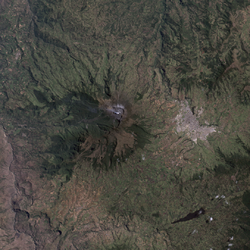
Galeras
Did you know...
This Wikipedia selection is available offline from SOS Children for distribution in the developing world. See http://www.soschildren.org/sponsor-a-child to find out about child sponsorship.
| Mountain name required |
|---|
Galeras (Urcunina among the indigenous people) is a volcano in Colombia, near the city of Pasto. Its summit lies 4,276 m (14,029 feet) above sea level. It has erupted frequently since the Spanish conquest, and in 1993, an eruption killed nine people, including six scientists who had descended into the volcano's crater to sample gases.
Geological history
Galeras has been an active volcano for at least a million years. Two major caldera-forming eruptions have occurred, the first about 560,000 years ago in an eruption which expelled about 15 cubic kilometres of material, and the second some time between 40,000 and 150,000 years ago, in a smaller but still sizable eruption of 2km³ of material. Subsequently, part of the caldera wall has collapsed, probably due to instabilities caused by hydrothermal activity, and later eruptions have built up a smaller cone inside the now horseshoe-shaped caldera.
At least six large eruptions have occurred in the last 5,000 years, most recently in 1886, and there have been at least 20 small to medium sized eruptions since the 1500s. In light of its violent eruption history and proximity to the 450,000 people of Pasto, Galeras was designated a Decade Volcano in 1991, identifying it as a target for detailed study as part of the United Nations' International Decade for Natural Disaster Reduction.
1993 eruption
Galeras had become active in 1988 after 10 years of dormancy. In January 14TH 1993, the volcano erupted when several volcanologists were inside the crater taking measurements. The scientists had been visiting Pasto for a conference related to the volcano's designation as a Decade Volcano. Six were killed, together with three tourists on the rim of the crater.
Controversy has surrounded the events of the disaster, with competing viewpoints represented in various books. Claims have been made that the leader of the expedition, Stanley Williams, ignored basic safety procedures, as well as seismic evidence that an eruption was imminent, thus placing himself and others in danger unnecessarily.
A prediction had been made three days before the eruption based on B-Type activity seen on a seismograph. Seismic B-types had been used successfully to predict eruptions on other volcanoes. However, Williams chose to do the risk assessment based on his own technique using gas emissions, which had indicated that there was little likelihood of an eruption at Galeras.
Twenty-first century activity

Activity at a low level has continued at Galeras, with small explosions occasionally dusting nearby villages and towns with ash. The volcano has continued to be well studied, and predictions of eruptions at the volcano have improved. One phenomenon which seems to be a reliable precursor to eruptive activity is a low-frequency seismic event known as a 'tornillo'. These have occurred before about four-fifths of the explosions at Galeras, and the number of tornillo events recorded before an eruption is also correlated with the size of the ensuing eruption.
More than 100 minor tremors were felt during a major eruption in April 2002, although no damage or injury was reported. An eruption in November 2005 forced an evacuation of the dangerous area surrounding the volcano and about 9400 people from nearby villages (mostly farmers) were ordered to leave. The city of Pasto, about 9 km from the volcano, was blanketed by a layer of ash after the volcanic explosion, forcing the residents to don goggles and face masks.
Numerous minor tremors and ash emissions since March 2006, culminated on Wednesday, July 12, 2006 in three explosive eruptions, producing an ash and gas column reaching an altitude of 8 kilometers. Rock falls and pyroclastic flows were reported from towns as distant as Consacá, 11.4 kilometers west of the main crater. The Colombian government has repeatedly ordered evacuations to temporary shelters, of more than 8500 people residing in the highest risk areas surrounding the volcano, with hopes of eventual assistance toward permanent relocation.
On Thursday, January 17, 2008 the volcano erupted around 8 p.m. There were no immediate reports of injuries or serious property damage.

